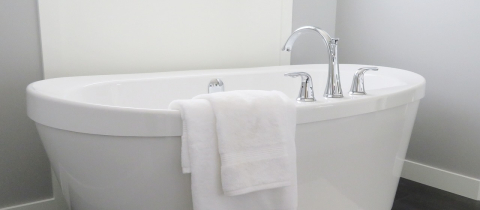You know those stories about some sort of chemical being added to swimming pool water that changes colour if someone uses the pool as a pee pot? Well, they are not true. There is no such chemical. But what is true, is that people pee in the water. The average person will leave behind about 50 Ml, which doesn’t sound too appetizing when we consider that every time you swallow a bit of pool water you are dosing yourself with some pee from all the other people in the pool. This is not much of a health risk since urine does not normally harbour pathogenic bacteria, but that doesn’t mean there is no problem. The urea in urine breaks down to yield ammonia and ammonia reacts with chlorine to form chloramines. These irritate the eyes and lungs and in fact account for most of the “swimming pool odour.”
While there is no colour reaction that can determine the urine content of swimming pool water, researchers from the University of Alberta have found a sweet way to estimate just how much pee we swim in. The key is the artificial sweetener acesulfame potassium, found in a variety of beverages and baked products. Why acesulfame potassium as the indicator? Because this chemical is not metabolized; so any amount that is detected reflects the amount that is originally ingested. And Since no artificial sweetener is added to pool water, any amount that is found must come from people’s pee. Every sample of pool water and hot tub water the researchers analyzed contained some acesulfame potassium. By measuring the amount, they came up with the estimate that the average person taints the water with about 50 ml of urine. It’s just an estimate because of course there are people who do not consume any artificially sweetened drinks or foods.
While chloramines are irritants, they have another side as well. They can be used as an alternative to chlorination in water disinfection. Without a doubt chlorination was one of the greatest technological innovations ever introduced. Before its use, cholera, typhoid fever and dysentery were common. Unfortunately, chlorination introduced some problems as well. Naturally occurring organic compounds in water, as well as some pollutants, can react with chlorine to form the notorious trihalomethanes, or THMs, which are likely carcinogens. Chloramines do not do this. That’s why many water treatment authorities are switching to the use of chloramines instead of chlorine. Chloramine is more stable than chlorine and lasts longer in the distribution system, providing increased protection.
At the levels used in drinking water, about 1 ppm, chloramines are safe. At higher concentrations the story is different. And that’s where urine comes in. In chlorinated swimming pool water, chloramine levels can rise above 1 ppm, depending on how many people are peeing in the water. The acesulfame potassium analysis can help track to what extent this is happening. So if your eyes are burning while swimming, chances are that someone has been fouling the water. Moral of the story? Let loose in the toilet, not in the pool.







